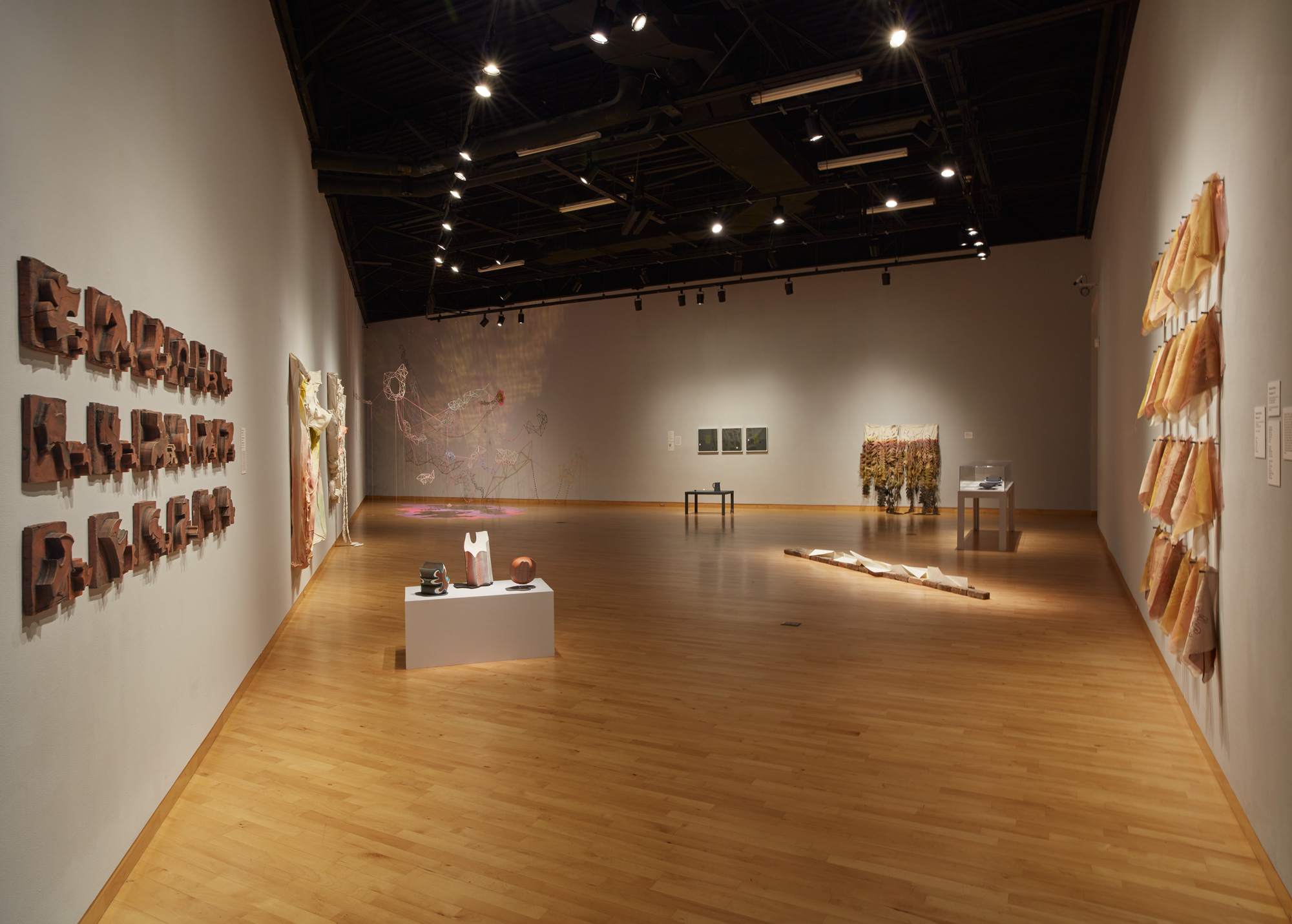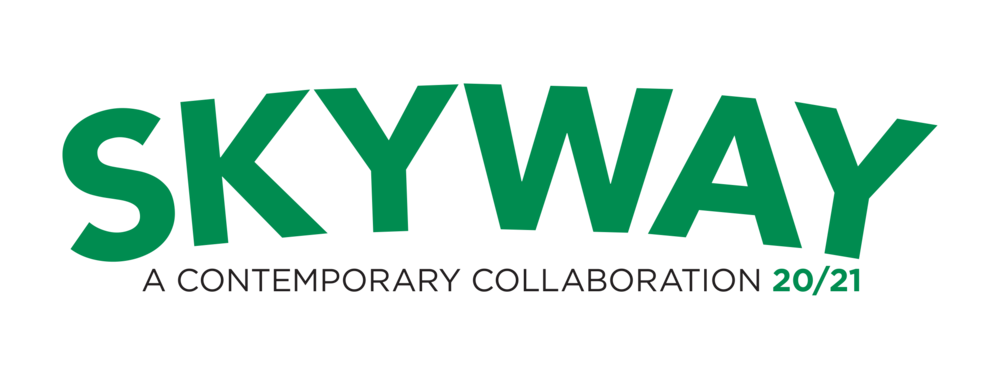Skyway 20/21: A Contemporary Collaboration
June 14 – September 1, 2021
USF Contemporary Art Museum + Online
USFCAM HOURS + ADMISSIONS
Monday-Friday 10am-5pm; Closed Weekends and USF Holidays (July 5) – Reservations required for visits June 14–25. No reservations required starting June 28 when USF lifts COVID restrictions on public access to campus.
Admission to the Museum is free; however, a USF parking permit ($5.00 daily) or pay-per-space parking is required. Please call (813) 974-4133 for questions regarding reservations, parking, directions, or more information on events associated with the exhibitions.
CAM EXHIBITION ONLINE
Exhibition Home // Essay by Sarah Howard // Foreword + Acknowledgements
Rosemarie Chiarlone // Danny Dobrow // Babette Herschberger // Akiko Kotani
Cynthia Mason // Ry McCullough // Casey McDonough // Kodi Thompson

Installation view of Skyway 20/21 exhibition at USF Contemporary Art Museum. Left to right: works by Kodi Thompson, Cynthia Mason, Casey McDonough, Ry McCollough, Cynthia Mason, and Rosemarie Chiarlone. Photo: Will Lytch.
Skyway 20/21 at USFCAM
Sarah Howard
Embodying the spirit of the iconic Skyway bridge that serves as a gateway spanning and connecting communities across Tampa Bay, Skyway 20/21 is the second iteration of the collaborative platform among four regional institutions, offering a vital reconnection with our cultural community at a time when we need it most. Following the traumatic period of isolation and social distance during the COVID-19 pandemic shutdown, intense anxiety, outrage, exhaustion, grief, hope, and resilience have propelled collective calls for long-overdue racial equity and systemic change across our economic, political, and institutional spheres. Our cultural compass and the power of artistic vision provide guidance in navigating society’s shifting currents in our post-pandemic journey forward. As in-person events and experiences are restored, we are honored by this special privilege to produce, present, and experience art in celebration with our community.
Skyway 20/21 at USFCAM features eight intergenerational artists who translate ideas and transform materials to communicate unique perspectives of our contemporary experience. Articulating visual languages through a range of media and processes, Rosemarie Chiarlone, Cynthia Mason, Ry McCullough, and Kodi Thompson offer opportunities to translate and decipher their individual lexicons that express the human condition. Danny Dobrow, Babette Herschberger, Akiko Kotani, and Casey McDonough highlight the complexities of their practice through deep material investigation and transformation. Collectively, the works create an expanded dialogue that speaks to our current moment, engaging and reflecting the social challenges of our time.
Rosemarie Chiarlone’s work explores the physical and psychological boundaries of human connection through the visual structure of text. Inspired by the poetry of her longtime collaborator and friend Susan Weiner, Chiarlone’s elegant constructions are layered with social and political contexts. Her artist-designed flag, Equity, symbolizes and participates in the ongoing struggle for racial parity. Delicately crafted handmade books, perforated works on paper, and sculptural installations incorporate graphic expressions of poems addressing the coronavirus. Issues of equity and otherness that are obscured or challenging to decipher generate layers of meaning to be reconstructed and expanded by the viewer.
Expanding the concept of a visual vocabulary, Kodi Thompson’s ceramic sculptures articulate a unique language of personal symbols inspired by urban design found in graffiti, architecture, and skateboarding culture. Developing his Alphabet of two-dimensional shapes into three-dimensional forms, Thompson extrudes clay through die-cut shapes to create dense, geometric columns, which he cuts, alters, and reconfigures into new abstract compositions—a process he describes as drawing in space. Glazed and cold-finish color treatments highlight the features of the sculptures’ extruded forms. Thompson’s ongoing material exploration and expanding visual lexicon transcends ancient and modern forms of communication and invites decoding and interpretation from multiple perspectives.
Ry McCullough’s practice engages the fields of printmaking, creative writing, drawing, sound, and sculpture to create unique systems that probe the margins and boundaries of how art constructs language and communicates meaning. These systems of making have the potential to expand or collapse, which generates opportunities for discovery in his thematic investigations of the philosophical, abstract, and fluid state of being across time and space. Inspired by the perfect game Los Angeles Dodgers’ pitcher Sandy Koufax threw against the Chicago Cubs in 1965, Themes for a Left-Handed Pitcher engages compositional fielding of the domestic pitcher and black and white balls in a callback and comparative dialogue between sculptural objects and works on paper. Inviting playful and participatory discovery, the project includes an amplified palindromic sound score and a zine, which are both available to download. Interspersed with the sounds and schematics of the game, discreetly placed baseball cards evoke a change-up between the fabricated and found forms, the known and the unknown.
Composing a visual language that merges the material and spatial boundaries of sculpture and painting, Cynthia Mason’s recent series speaks to the artifice of humanity’s authority over the natural world in our age of the Anthropocene. Fascinated by the overlap and edges of topographies, her work melds the corporeal and the geological with fleshy folds, sagging forms, prickly limbs, and gaping orifices that gesture to a link between our own skin and the surface of the Earth. Limp grids and stacks, precariously supported by loose threads and armatures that threaten to unravel and collapse, suggest the instability of our infrastructure and inadequacy of social systems to respond to our fraught relationship with the natural environment. Stained with pigments, crusted with minerals, and adorned with aristocratic beauty marks, the soft sculptural works incorporate contrasting materials of rich velvet and utilitarian canvas to comment on society’s preoccupation with superficial status as we face impending failure in our urgent anthropogenic moment.
Babette Herschberger’s practice also looks to juxtapositions between the built environment and the natural world. Intrigued with how erected structures, such as billboards, architecture, and urban infrastructure contrast and intersect with the landscape, Herschberger works intuitively to create abstract compositions with minimal color and form to emphasize surface. Using informal and banal materials, she uses collage to build pigmented layers generating sublime surfaces of planes and forms that function as a form of drawing within painting. Installed to draw the viewer’s eye across the shifting planes within the work, her boldly colored compositions suggest objects, structures, and shadows as interruptions within the decentered horizon.
Weaving intersections between art, nature, and science, Casey McDonough mines the contradictions present in our human experience with the natural world by investigating the transformative and transcendent potential of material. Anchored and suspended in a corner of the gallery, delicate clay girders expand structurally when intertwined into a larger constellation of bright, luminous, and reflective material forms. Amplified and echoed through shadow and repetition, celestial contours and biomorphic patterns spotlight macro and micro perspectives; smaller gestures invite close observation while broader connections reveal a volumetric presence and intricate dialogue between spatial and material exploration.
In her monumental installation Red Falls, Akiko Kotani expands her material exploration of crochet stitching as a transformative act which honors the strength and resiliency of abused women, materially interwoven with the trauma and power carried and contained within their bodies and psyche. Using thread created from red plastic trash bags, over two dozen crocheted panels cascade like a waterfall and flow onto the gallery floor suggesting the natural and potent functions of women’s bodies. The softness of the material and expansive scale of the work exaggerates each stitch, a part of her process she considers as a journal, recording and reflecting her emotions as she works. Kotani’s stitching process symbolizes the repetitive and patient nature of women’s domestic labor, which is often unrecognized and undervalued.
Danny Dobrow expands his ongoing conceptual discourse with the field of craft, and specifically pottery, with a playful interrogation of the cultural hierarchies between the disciplines of craft, pottery, fine art, and design. Employing appropriation to craft a fabricated narrative, Dobrow presents the working studio of the fictional artist Martin Martin. Building the imagined history of the ceramicist’s successful early career with functional objects, Dobrow’s accompanying exhibition catalogue for Martin Martin on View: The Hyper Pots explains the evolution of Martin’s career. After renouncing and destroying some of his early works, Martin reimagined a series of white vessels through two phases, resulting in highly saturated objects oozing with contemporary materiality and primed for the digital stage of a social media era. Hyper Pots refers to a movement within contemporary ceramics where a proliferation of highly decorated and extreme glaze surfaced ceramics on Instagram propelled the field of ceramics into the valuable blue-chip art market.
With innovative and distinct approaches to creative practice, the Skyway 20/21 artists inform and expand our understanding of our contemporary context, new perspectives and dialogue to address some of our most pressing social conditions. Together, their contributions demonstrate the exceptional caliber of artistic talent, aesthetic and material concern, and conceptual rigor located in our creative community. Skyway’s collaborative model and regenerative platform reinforce the vital role artists and art institutions play in opening dialogues about contemporary culture and expanding, uniting, and sustaining our community’s social networks through shared experience.
Sarah Howard
Curator of Public Art and Social Practice
USF Institute for Research in Art
Skyway 20/21: A Contemporary Collaboration at the USF Contemporary Art Museum is supported by the Gobioff Foundation, the Stanton Storer Embrace the Arts Foundation, the Lee and Victor Leavengood Trust, and Dr. Allen Root in honor of his late wife Janet G. Root.

